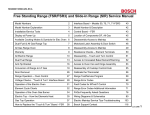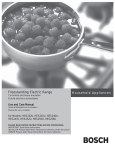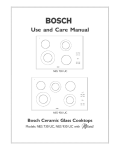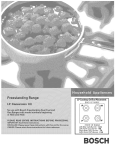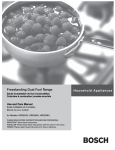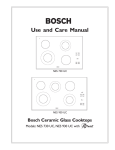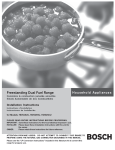Download 2 - MSA World
Transcript
RANGE TRAINING MANUAL ALL ELECTRIC - DUEL FUEL - ALL GAS Range Training Program Contents Page Number Model Numbers Product Description Features Warranty Installation Operation Disassembly Reassembly Thermostat Calibration Test / Service Programs Error Codes Wiring Diagrams Service Tips 2 6 8 25 26 43 57 70 73 75 85 88 105 1 Model Numbers…All Electric Ranges HES252U…. Most featured model, 30” White HES255U…. Most featured model, 30” Stainless HES256U…. Most featured model, 30” Black HES242U…. Medium featured model, 30” White HES245U…. Medium featured model, 30” Stainless HES246U…. Medium featured model, 30” Black HES247U…. Medium featured model, 30” Biscuit HES232U…. Standard featured model, 30” White HES235U…. Standard featured model, 30” Stainless HES236U…. Standard featured model, 30” Black 2 Model Numbers…Duel Fuel Ranges HDS252U…. Most featured model, 30” White HDS255U…. Most featured model, 30” Stainless HDS256U…. Most featured model, 30” Black 3 Model Numbers…All Gas Ranges HGS252UC….Most featured model, 30” White HGS255UC….Most featured model, 30” Stainless HGS256UC….Most featured model, 30” Black HGS242UC….Medium featured model, 30” White HGS245UC….Medium featured model, 30” Stainless HGS246UC….Medium featured model, 30” Black HGS247UC….Medium featured model, 30” Biscuit HGS232UC….Standard featured model, 30” White HGS235UC….Standard featured model, 30” Stainless HGS236UC….Standard featured model, 30” Black 4 Model Number…Explanation The first three letters indicate product type: HES….All Electric, HDS….Dual Fuel, HGS….All Gas The first two numbers indicate the level of features: 25….Most features, 24….Medium features, 23….Standard features The third number indicates the color: 2….White, 5….Stainless, 6….Black, 7….Biscuit The next two letters….UC….Indicates United States & Canada. If UC model only has a U, it is not certified for Canada. These last two letters will be followed in production by…./01, /02, /03 etc, this indicates the service code level, and must be included as part of the model number to ensure that the correct parts are ordered for 5 service Product Description The Electric Range has three models offering a range of features. This product description section will describe the HES25UC which is the range with the most features The cooktop section features a Touch & Turn TM sensor pad with a central control dial that operates all cooktop functions. Unlike an ordinary dial mTwisT is held to the cooktop with a magnet mounted behind the control panel. When lifted off, it Note Standard models feature reveals a smooth, glass mechanical controls with knobs surface for easy cleaning 6 Product Description All Electric Range • Widest oven cavity • Touch & Turn TM oven control • Automatic oven light • mTwist TM cooktop control • Largest warming drawer • Genuine European Convection • Flexible element sizes • Low profile cooktop • UltraSpeed TM elements • Flush to cabinet front • Electronically controlled warming drawer • Largest oven window • Full extension oven rack Note Not all models have all the features 7 Features The UltraSpeed TM elements are in every Bosch electric top. The elements are very high quality and have a longer lifespan than traditional coils or halogen elements. The elements respond either on or off within three seconds and cycle on and off to maintain temperature. Dual and Triple rings allow for expansion of the elements to increase the size of the cookware that can be used. This expansion provides the most versatile amount of cooking area 8 in a cooktop configuration mTwist TM -- Touch & Turn TM Operation • Two step operation • Simple and intuitive to operate • Ceramic glass control panel • Touch to choose element • Turn to change power level • Removable knob • Safety power off • Easy to clean 9 Keep Warm Feature • All elements have a “keep warm” feature on mTwisT TM models • Elements remain on at 3% wattage • Excellent for holding or simmering foods • Indicates “keep warm” on all zones by the letter “L” for low heat 10 Product Description -- Touch and Turn TM Control Powerful technology made easy to use. Functions are selected with the touch-through-glass sensor pad, then all settings are adjusted with one central dial. It’s another Bosch innovation that simplifies high technology with a very intuitive and easy-to-use control 11 Control Panel Display • Clear text display • Intuitive operation • Automatic help prompt • Animated display • Indicates preheat temperature • Chime tones to indicate operation • Select menu • Displays oven & warming operations 12 Control Panel Display -- Options • “Lock Keys” • Beep volume • Sabbath mode selection • Visible clock or no clock • Oven calibration • Demonstration mode • English, French or Spanish • Original factory settings • F or C degree display • 12 or 24 hour clock 13 Control Panel Display -- Features Electronic Thermostat: The oven regulates temperature by using a premium sensor with state of the art software to control the elements. Temperatures can be set from 100 F to 550 F in 5 degree increments. Digital Display Window: The range has a full text display window. The window displays: • Clock • Active elements • Timer settings • Temperature • Temperature probe settings • Preheating • Warming drawer indicator • Remove rack reminder • Cooking mode • lock indicator • Timed cooking mode • Sabbath mode 14 Oven -- Features Cooking Modes: The range has one of the most versatile ovens on the market today, with 10 different cooking modes everything is possible. • Automatic Temperature Probe • Thermal Bake • Convection Bake • Dehydrating • Convection Roast • Proof Mode • Broil • Sabbath Mode • Keep Warm Mode • Convection Broil Timed Cooking Modes: Set the oven to cook in convection roast, convection bake or thermal bake for a set period of time. The oven shuts off once the set cooking duration has been reached. This mode makes following a recipe easy and worry-free. 15 Oven Delayed Start Cooking: User can set the oven to come on at a specific time, and cook for a specific amount of time. Meals are then ready when the user gets home. -- Features Two Timers: Timing is easy with built in timers that beep and acknowledge time is up. Self-Clean with Rack Removal Reminder: Self-cleaning is an automatic 4 hour cycle, or it can be manually set from 3to 5 hours. Once the cycle is set the oven beeps and tells the user to remove the racks. Once the oven reaches 350 F the oven door locks for safety. Self-clean temperature is 850 F. Sabbath Mode: The Sabbath mode allows the oven to remain on with or without the light in thermal bake mode for up to 48 hours. 16 Oven Elements Broil Element: 10-pass broil element 3,250 watts of power. Even heat distribution, recessed for safety, longevity and clean-ability. Convection Element: Gives genuine European convection TM 1,100 watts of power. Enhances multi-rack and full meal cooking, better baking and browning. Bake Element: 8-pass bake element which is hidden for safety, longevity and clean-ability. 2,000 watts of power. Takes 10 to 13 minutes to reach 350 F in bake mode. 17 Available Cooking Modes Electric Oven Cooking Mode Symbol Default Temperature Temperature Range Elements Convection Bake 325 degrees F 100 to 525 degrees F Upper, lower and third rear Thermal Bake 350 degrees F 100 to 550 degrees F Upper and lower Convection Roast 325 degrees F 100 to 525 degrees F Upper and lower Thermal Broil 450 or 550 degrees F Low or High Upper Convection Broil 550 degrees F High (550 degrees F) Upper and convection fan Temperature Probe 0 degrees F 100 to 300 degrees F Refer to all bake modes Dehydrate 140 degrees F 100 to 160 degrees F Proof 100 degrees F 85 to 110 degrees F Third rear and convection fan Upper and lower Sabbath 350 degrees F 100 to 550 degrees F Upper and lower Light on or off Keep Warm 170 degrees F 140 to 225 degrees F Upper and lower Chart shows which elements are on in each of the cooking modes 18 Product Description - - Oven Cavity • 25” extra-wide oven cavity (4.6 cu. Ft.) • Six rack positions • Telescopic Rack…allows users to check and view food without having to pull the cookware out of the oven. Holds up to 50lbs. • Automatic Temperature Probe. • Concealed Bake Element. Electronic Thermostat. • Electronically controlled oven lighting via door opening or touch control-2 x 40 watt incandescent bulbs, staggered for better viewing 19 Oven Chassis The oven can is built onto a chassis for sturdy construction, and is built to last. This means fewer gaps and a professional engineered fit. 20 Product Description -Warming Drawer • Electronically controlled temperature via sensor • Extra wide • 400 watt element mounted under drawer, safe for take out containers • High, medium and low settings • Full extension ball bearing glides. • Stainless steel mirror finish • 1.3 cu.ft. 21 Duel Fuel & All Gas Range Top Product Description • Pro-Style continuous grates • Low-profile to countertop • Power-Sim Burner (Diffuser Burner) • Sealed burners • Electronic ignition • Optimized burner spacing • Precision Flame Control 22 Duel Fuel & All Gas Range Top -- Features Burner Ratings: RF Burner Power-Sim TM – 15,000 to a low of 1200 but with cap takes heat output down to 400 to 500 BTUs RR Burner 800 – 5,500 LF Burner 1,200 – 9,100 LR Burner 1,400 – 12,500 23 All Gas Range Oven -- Features • Bake…17,000 BTUs • Broil…14,500BTUs • Electronically controlled • Flame diffuser • Even heat distribution • Glow-bar silicon carbide igniter • Low profile cover for more usable cooking surface 24 Warranty • One full year Parts & Labor from date of installation or occupancy • Additional four years part only on the following cooktop section parts – electrical controls, heating elements and ceramic glass top. • Service must be performed by an authorized service agency • Warranty Claim must be submitted within 45 days of completion 25 Installation…All Electric Range Electrical Connections: Range requires a 50 Amp 120 / 240 VAC or 120 / 208 VAC dedicated circuit preferably with a four wire connection, however where local codes and ordinances permit grounding through the neutral and / or conversion to four wire is impractical, unit may be connected to the power supply via a three wire connection. Connection can be made via a range cord or a flexible conduit. If a range cord is used it must meet the above rating requirements and be marked “For use with Ranges” 1 26 Installation…All Electric Range continued Electrical Connections 22 27 Installation…All Electric Range 3 28 Installation…Duel Fuel Range 4 29 Installation…Duel Fuel Range 5 30 Installation…Duel Fuel Range 6 31 Installation Anti-Tip Bracket…. Anti-Tip bracket must be installed as shown below 7 32 Installation 8 33 Conversion of Range to LP Gas -- Kit is supplied with the range Duel Fuel LP Kit part # 438629 All Gas LP Kit part # 437777 34 LP Conversion -- continued 35 LP Conversion -- continued 36 LP Conversion -- continued 37 LP Conversion -- continued 38 LP Conversion -- continued 39 LP Conversion -- continued 40 LP Conversion -- Continued 41 Door Removal 42 Operation -- Oven Control X3 When the range is powered up, the interface board receives the voltages at X2 from the power relay board shown in the chart on the next page, and the clock illuminates. Connector to Power Relay Board from “Touch & Turn” User Interface Board (clock) Connector to “Touch & Turn” User Interface Board (clock) from Power Relay Board X2 This board controls all the functions of the oven and contains the program data 43 Voltage checks at the “Touch & Turn” interface board (clock) X2 Voltage readings at X2 NOTE pin connections are not marked 1) 1.5 VDC 2) 0 VDC 3) 0 VDC 4) 5 VDC 5) 6) 7) 8) 0 VDC 8 VDC 0 VDC 32 VDC Remove connector from board , set scale to +50VDC, put one meter lead to ground and the other lead to pins 1, 4, 6 and 8 in turn.Voltage should read as indicated in the chart. If voltages are good and no display is present, replace the interface board. 44 X23 X3 Wiring Harness to Interface Board K8 X6 Latch Switches X5 Door Switch X7 Meat Probe X25 Warm Drawer Sensor K10 K7 X8 Oven Sensor K6 K4 Power Relay Board Connections Electric Oven Lamps K10 Convection Motor K7 Latch Motor X21 Neutral X22 K6 out to Warming Ele. X24 L1 (Red) Input to K6, K7,K8 & K10 X17 L2 (Black) Input to K4 X16 K4 to Bake & Conv Elements X15 K3 out to Bake Element K3 X4 Ground K8 N E U T R A L X18 L1 (Red) Input to K5 & K3 K5 X19 K5 out to Conv. Element K2 X13 L2 (Black) Input to K2 X12 K2 out to Broil Element K1 X11 K1 out to Broil Element X10 L1 (Red) Input to K1 X1 L1 (Red) Input to Board X2 Neutral (White) to Board 45 X3 Wiring Harness to Interface Board X6 Latch Switches X5 Door Switch X7 Meat Probe X25 Warm Drawer Sensor X8 Oven Sensor K8 K8 K9 K10 K10 K7 K7 K6 K6 X23 K8 Lamps K10 Convection Motor K7 Latch Motor N E U T R A L X21 Neutral X22 K6 Out to Warming Ele. X24 L1 Input to K6, K7,K8 & K10 X4 Ground Power Relay Board Connections Gas Oven K12 K12 K12 K11 K11 X12 From K12 to Broil Valve Coil X11 L1 Input to K11 & K12 X10 From K11 to Bake Valve Coil X1 L1 (Red) Input to Board X2 Neutral (White) to Board 46 Operation of the Electric Oven 1 2 3 4 Touch Bake and set temperature at the control, relay board receives input and checks resistance of sensor. If heat is required then the following relays will close: K3 & K4 for the bake element and K1 & K2 for the broil element. The output voltages from the board should be as follows: X15-L1 to bake element, X16-L2 to bake element. X11-L1 to broil element, X12-L2 to broil element. This supplies 120volts from L1 & L2 giving each element 240 volts and oven heats. NOTE See charts on next page for element “On Times”. 5 47 Element Cycle Charts CONVECTION BAKE MODE 48 Element Cycle Charts 49 Operation of the Electric Oven Note Some of the wiring diagrams show a high temperature safety thermostat between the terminal block and the power relay board. This HTC was not used on production units. 50 Operation of the Oven Gas Burner 1 2 3 4 K11 Touch Bake and set temperature at the control, relay board receives input and checks resistance of sensor. If heat is required then Bake relay K11 is closed. 120VAC is sent to the gas safety valve. The glow igniter which is wired in series with the valve starts to heat up, as it does so the voltage drops across the valve. When the glow bar draws 3.2 amps and is glowing the valve opens sending gas to the burner and it ignites. Bake is 17,000 BTUs 5 51 Electric Top Operation -- Controls To select heating level, touch desired element, then twist knob. 1 2 To turn off element, touch until “0” appears. To keep food warm, touch element key, then touch keep warm key. To size pots for dual or triple elements, press desired element, then press pot sizing key and then rotate knob to desired heating level. If panel lock came on (if magnetic knob was removed for > 10 seconds), replace knob, then push and hold down panel lock touch key until panel lock light goes out. 52 Electric Top Operation -- Typical Displays Residual Heat Element On (showing heat level) Dual (Outer) Element On (showing heat level) Element Off Low (keep warm) Panel Lock On (when knob missing) 53 Electric Top -- How the Elements Heat Each element or section of an element is controlled by a relay. Touch the glass to select element, turn knob to select the power level. For the element to heat the following relays must close: Left Front & Right Front L2 from K10 measured at X30. Left Front L1 from K1 900 watt measured at X5 L1 from K3 800 watt measured at X7 triple element L1 from K4 800 watt measured at X8 Right Front L1 from K2 1200 watt measured at X6 single element Right Rear & Left Rear L2 from K9 measured at X32. Right Rear L1 from K5 1100 watt measured at X9 double element L1 from K6 800 watt measured at X12 Left Rear L1 from K7 1500 watt measured at X11 See next page for example schematic single element 54 Electric Top -- How the Elements Heat L1 L2 N 55 Gas Top Operation 1 2 Spark Switch 3 Sim. Light This switch is only for the Super-Sim burner Turn the control knob to the lite position. The spark switch closes and sends 120VAC to the spark module. The spark module output sends 14,000VDC to the burner igniter creating a spark to the underside of the burner cap. The action of turning the knob to the lite position allows gas to flow to the burner and it ignites 4 5 6 56 Gas Top Operation Spark Switch (4) Sim. Light This switch is only for the Super-Sim burner Note spark switches are supplied as an assembly of four complete with wiring harness part # 492439 56A How to replace the “Touch & Turn” interface board (clock) Remove the Knob: It is a tight fit, wrap some scotch tape around the knob & pull gently on the ends to remove. Remove the locknut Remove upper rear access panel, remove connector from board, remove the 6 screws holding the board. Reassemble new board in reverse order after checking the board configuration. See next page for instructions. 57 When a replacement board is ordered, all “Touch & Turn” interface boards are programed for the MEDIUM featured models for example HXS24XU: For the MOST featured model HXS25XU snap off either one of these tabs. For the LEAST featured model example HXS23XU, snap off both tabs. Note be sure to check the model # of the range and configure the board correctly before installing. 58 Location of components Duel Fuel & All Gas Range Relay Board Gas regulator & connection point Spark Module Convection Motor Access to warming drawer element terminals Gas safety valve 59 Disassembly….Access to maintop 1 No need to remove these screws 3 2 Tabs Slots Remove knobs first if unit has mechanical controls or is a gas top. Remove the two screws under the front panel, support the panel as you take out the second screw so that it won’t fall. Panel is also held in place with two support tabs which fit into slots on sub-panel 5 4 Remove these screws 60 Disassembly….Access to maintop 6 7 Remove the 12 screws which hold the 2 rear panels and disconnect the ground screw from the maintop support Ground Screw Lift the maintop a couple of inches to disengage the locking tabs and slide towards the front of the unit. Lift the front of the maintop and fold back against the control panel. (place towel or blanket over control panel to avoid scratching panel or maintop) The elements, control, and latch assembly can now be accessed. 8 9 10 61 Motorized Latch Assembly & Door Switch Remove 2 screws from front frame Latch Motor Latch can be accessed from under the cooktop Latch Switches Plunger Light Switch 62 Disassembly -- Access to maintop Mechanical version Each pair of elements are held in place by a single bracket & two tension clips per element Touch & Turn control version Retaining Brackets Tension Clips 63 Resistance checks can easily be made at the element terminals Turn off power before beginning resistance checks Right Front Single Element 1200W LF Triple Element 2500 Watts 2-1 70.7 Ohms 2-4 71.3 Ohms 2-3 63 Ohms 3 4 1 2 2-4 46.3 Ohms Right Rear Double Element 1900W Left Rear Single Element 1500W 2-4 37.3 Ohms 2-3 50.6 Ohms 2-4 68.5 Ohms 64 Disassembly – Touch & Turn control 1 2 3 Disconnect wires as needed. Remove 2 screws holding cover Support bracket is held with 2 screws 4 Remove the support bracket 5 Lift board up and out. 6 CAUTION: Take care not to break the plastic board standoffs. 65 Disassembly – Touch & Turn control 7 Bottom of board showing display and magnetic switch Underside of control showing touch pads and magnetic switch 66 Access to concealed bake element & warming element Rear Warming element removed from front by removing the drawer Remove this cover for access to the warming drawer element terminals Front Rear Remove this cover for access to the bake element 67 Access to Oven Can and Hinge Assembly 1 2 3 Remove latch assembly & top panels. Remove 3 screws on top of side panel, lift up & out to disengage tabs at the bottom. Remove screws holding outer & inner galvanized panels. Remove insulation (it is all in one piece) oven can is easily removed from chassis by removing front and rear chassis frame screws. (see instructions on next page). 4 5 6 68 Access to Oven Can and Hinge Assembly -continued Remove these screws 69 Reassembly -- Control board (1) The control board must be reassembled so 4 of the 6 light blue standoffs (“pins”) engage the 4 holes in the metal plate glued to the Ceran glass maintop. If not, the magnetic knob & digital displays won’t line up. NOTE: The other 2 standoffs don’t engage any holes in the plate. CAUTION: Don’t force the standoffs in place (so they’re not broken). 70 Reassembly -- Control Board (2) Before mounting the control board, make sure each of the 6 light blue standoffs (“pins”) are inserted properly into the component boards. The two boards should be parallel. In addition, make sure there is no debris between the touch pads and the glass, and that the pads are making good contact with the glass. If not it will not work and may show an error code. 71 Reassembly of cooktop control knob, spring & bezel 1 3 Assemble knob spring & bezel. Hold assembly together and install on shaft 2 4 72 How to calibrate the Thermostat ( change the offset ) Touch cooking mode & keep your finger on there until “SELECT FUNCTION” appears (about 5 secs.) 1 3 Using control knob, scroll through menu until “OVEN TEMP OFFSET” appears. Touch start and a number will appear in the temperature window. If the oven has never been calibrated before it will be 0 degrees F 2 4 73 5 6 Using the control knob scroll through the temperature options. The temperature ranges from –25 degrees F to + 25 degrees F . Select the number of degrees that the temperature needs to be changed by and touch “START”. Display will show “SELECT FUNCTION”, touch “OFF” to complete the change. 7 74 Range Test / Service Program The range control has a service program that can be accessed by the service technician to check component and /or function. To enter the service program, do the following: Place a finger on the cooking mode, temperature and start zones simultaneously for 5 seconds… the word “TEST” will display. Touch cooking mode and “SERVICE” will display. 1 2 75 Touch start and “LIGHT” will display, at this point the light function can be tested by touching start again, or use the rotary control knob to scroll through the different test functions. To check a particular function rotate to that function then touch start. To exit the program at any time touch cancel. Note: During all functions the maximum oven temperature is 200 degrees F, if reached the display shows “TOO HOT” and any function in operation stops, except the Cancel ( which allows exit from the program).The test can be resumed once the temperature falls below 200 degrees F. 3 4 76 Electric Oven Function 1: 1. Display “LIGHT” 2. Press Start Zone to activate oven light relay. 3. Display “ LIGHT ON” 4. Press Start Zone to de-active oven light relay. 5. Display “LIGHT” 6. Allow user to continue toggling. 7. Rotating the selection knob will de-activate the light relay (if on) and scroll display to function select (Light, Conv Fan, Ring, etc.). Function 2: 1. Display “CONV FAN” 2. Press Start Zone to activate Convection fan relay. 3. Display “ FAN ON” 4. Press Start Zone to de-active Convection fan relay. 5. Display “FAN” 6. Allow user to continue toggling. 7. Rotating the selection knob will de-activate the Fan relay (if on) and scroll display to function select (Light, Conv Fan, Ring, etc.). 77 ( g g ) Function 3: 1. Display “RING” (if applicable for version) 2. Press Start Zone to activate Conv. fan relay and Ring element relay. 3. Display “ RING ON” 4. Press Start Zone to de-active Conv. Fan relay and Ring element relay. 5. Display “RING” 6. Allow user to continue toggling. 7. Rotating the selection knob will de-activate the Ring and Fan relay (if on) and scroll display to function select (Light, Conv Fan, Ring, etc.). Function 4: 1. Display “BROIL” 2. Press Start Zone to activate Broil element relay. 3. Display “ BROIL ON” 4. Press Start Zone to de-active Broil element relay. 5. Display “BROIL” 6. Allow user to continue toggling. 7. Rotating the selection knob will de-activate the fan relay (if on) and scroll display to function select (Light, Conv Fan, Ring, etc.). 78 Function 5: 1. Display “BAKE” 2. Press Start Zone to activate Bake element relay. 3. Display “ BAKE ON” 4. Press Start Zone to de-active Baker element relay. 5. Display “BAKE” 6. Allow user to continue toggling. 7. Rotating the selection knob will de-activate the Bake relay (if on) and scroll display to function select (Light, Conv Fan, Ring, etc.). Function 6: 1. Display “WARMING DRAWER” (if applicable for Version) 2. Press Start Zone to activate Warming Drawer element relay. 3. Display “ WARMING D ON” 4. Press Start Zone to de-active Warming Drawer element relay. 5. Display “WARMING DRAWER” 6. Allow user to continue toggling. 7. Rotating the selection knob will de-activate the Warming Drawer relay (if on) and scroll display to function select (Light, Conv Fan, Ring, etc.). 79 Function 7: 1. Display “SENSOR CHECK” 2. Press Start Zone to active control to automatically perform self check of: 3. Self check for Meat probe resistance (if applicable for version) 4. Self check for oven sensor resistance 5. Self check for warming drawer sensor resistance (if applicable for version) If self-check finds a failure during this sensor check, the alpha display shows which one with “FAILURE PROBE” or “FAILURE OVEN” or “FAILURE W D” 6. If no failure is found, the Display shows “SENSORS OK” 7. Rotating the selection knob will de-activate the Sensor check mode and scroll display to function select (Light, Conv Fan, Ring, etc.) Function 8: 1. Display “CHECK LATCH” 2. Press Start zone. Control activates door latch. Control operates as if in normal self-clean mode, checking for switch logic and time out functions. Lock icon should operate as in normal operation. Once latch is locked, motor stops and icon is steady state. All errors should show if malfunction or non-locking is detected. Further pressing of the Start Zone will be ignored until the latch has locked or an error has been detected. 3. Press Start zone. Control de-activated door latch. Control operates as if in normal selfclean mode, with all checks, icon change (lock flashing then off) and error detection. Further pressing of the Start Zone will be ignored until the latch has un-locked or an error has been detected. 4. If an error is detected, the latch motor will stop and the display will show that code and beep. 5. Allow user to continue toggling. 6. Rotating the selection knob will de-activate the Check Latch mode and reset to home (if locked) and scroll display to function select (Light, Conv Fan, Ring, etc.). 80 Gas Oven Function 1: 1. Display “LIGHT” 1. Press Start Zone to activate oven light relay. 2. Display “ LIGHT ON” 3. Press Start Zone to de-active oven light relay. 4. Display “LIGHT” 5. Allow user to continue toggling. 6. Rotating the selection knob will de-activate the light relay (if on) and scroll display to function select (Light, Conv Fan, Warming Drawer, etc.). Function 2: 1. Display “CONV FAN” 2. Press Start Zone to activate Convection fan relay. 3. Display “ FAN ON” 4. Press Start Zone to de-active Convection fan relay. 5. Display “FAN” 6. Allow user to continue toggling. 7. Rotating the selection knob will de-activate the Fan relay (if on) and scroll display to function select (Light, Conv Fan, Warming Drawer, etc.). 81 Function 3: 1. Display “WARMING DRAWER” (if applicable for Version) 2. Press Start Zone to activate Warming Drawer element relay. 3. Display “ WARMING D ON” 4. Press Start Zone to de-active Warming Drawer element relay. 5. Display “WARMING DRAWER” 6. Allow user to continue toggling. 7. Rotating the selection knob will de-activate the Warming Drawer relay (if on) and scroll display to function select (Light, Conv Fan, Warming Drawer, etc.). Function 4: 1. Display “SENSOR CHECK” 2. Press Start Zone to active control to automatically perform self check of: 3. Self check for Meat probe resistance (if applicable for version) 4. Self check for oven sensor resistance 5. Self check for warming drawer sensor resistance (if applicable for version) If self-check finds a failure during this sensor check, the alpha display shows which one with “FAILURE PROBE” or “FAILURE OVEN” or “FAILURE W D” 6. If no failure is found, the Display shows “SENSORS OK” 7. Rotating the selection knob will de-activate the Sensor check mode and scroll display to function select (Light, Conv Fan, Warming Drawer, etc.). 82 Function 5: 1. Display “BROIL” 2. Pressing Start Zone activates Broil relay for 120 seconds 3. Display “BROIL ON” 4. Pressing Start Zone De-activates Broil relay 5. Display “BROIL” 6. Allow user to continue toggling. 7. While Broil is on, Controller times for 120 seconds. If user does not turn off broil relay within the 120seconds, controller turns off automatically (also max temp of 200F is monitored). 8. Rotating the selection knob will de-activate the Check Latch mode and reset to home (if locked) and scroll display to function select (Light, Conv Fan, Warming Drawer, etc.). Function 6: 1. Display “BAKE” 2. 2. Pressing Start Zone activates Bake relay for 120 seconds 3. Display “BAKE ON” 4. Pressing Start Zone De-activates Bake relay 5. Display “BAKE” 6. Allow user to continue toggling. 7. While Bake relay is on, Controller times for 120 seconds. If user does not turn off broil relay within the 120seconds, controller turns off automatically (also max temp of 200F is monitored). 8. Rotating the selection knob will de-activate the Check Latch mode and reset to home (if locked) and scroll display to function select (Light, Conv Fan, Warming Drawer, etc.). 83 Function 7: 1. Display “CHECK LATCH” 2. Press Start zone. Control activates door latch. Control operates as if in normal self-clean mode, checking for switch logic and time out functions. Lock icon should operate as in normal operation. Once latch is locked, motor stops and icon is steady state. All errors should show if malfunction or non-locking is detected. Further pressing of the Start Zone will be ignored until the latch has locked or an error has been detected. 3. Press Start zone. Control de-activated door latch. Control operates as if in normal selfclean mode, with all checks, icon change (lock flashing then off) and error detection. Further pressing of the Start Zone will be ignored until the latch has un-locked or an error has been detected. 4. If an error is detected, the latch motor will stop and the display will show that code and beep. 5. Allow user to continue toggling. 6. Rotating the selection knob will de-activate the Check Latch mode and reset to home (if locked) and scroll display to function select (Light, Conv Fan, Warming Drawer, etc.). 84 Range Error Codes CODE DESCRIPTION Cook or clean programmed When W. Drawer is active Latch should be locked Latch should be unlocked Always Latch unlocked Latch locked Always FAULT LIMIT 20 sec 20 sec 1 min 1 min 1 min 5 sec 5 sec 1 min Always 1 min Slave micro not functioning Eeprom failure or communication circuit failure User Interface too hot Power Board too hot Cook profile corrupted in EPROM Always Cook or clean programmed Always Always Cook or clean programmed 1 min 1 sec 1 sec 1 sec 1 sec F170 F190 F200 Power Failure Power over voltage Time out and stop function 2 ms F210 Range exceeded safe test limits Always At power on During Production test mode During Service test mode F31 F33 F41 F43 F45 F111 F113 F121 Oven temperature sensor failure Warming Drawer Sensor Failure Motorized latch will not lock Motorized latch will not unlock Motorized Latch both locked and unlocked Runaway Oven temperature 585°F Runaway Oven temperature 950°F Stuck key in the membrane switch layer F125 Cancel key circuit problem F141 F151 F153 F154 F155 WHEN CHECKED 110 sec. 200°F 85 Range Error Codes -- Additional Information CODE F1 F2 F3 DESCRIPTION Meat probe not there or incorrect WHEN CHECKED During test / use Oven sensor not correct During test / use Warming sensor not correct During test / use DOOR Door latch problem LATCH ERROR During self-clean ERROR Temp. reaches 585 degrees F . Display shows “ During any CONTACT SERVICE” and beeps. The beep cooking mode can be stopped with touching cancel zone, but display will stay up with program locked until main power is removed for a minimum of 5 seconds. If the temperature continues to rise (due to stuck relay) the latch will lock at 600 degrees F Note: Depending on model, program will only look for probes or sensors that it should have. 86 Wiring Diagrams & Schematics There is a wiring diagram & schematic on the rear cover of each range 87 HES25U Wiring Diagram 88 L1 Red L2 N HES25U Cooktop Schematic 89 HES25U Oven Schematic 90 HES 24U Wiring Diagram 91 L1 L2 N HES24U Cooktop Section Schematic 92 HES24U Oven Section Schematic 93 HES23U Wiring Diagram 94 HES23UC Schematic 95 HDS25UC Wiring Diagram 96 HDS25U Schematic 97 HGS25UC Wiring Diagram 98 L1 N HGS25UC Cooktop Section 99 HGS25UC Oven Section 100 HGS24UC Wiring Diagram 101 HGS24UC Schematic 102 HGS23UC Wiring Diagram 103 HGS23UC Schematic 104 Electric Maintop Service Tips -Troubleshooting Symptom Problem Solution Panel lock Magnetic knob has been Replace magnetic knob, then press and hold light is on. removed or panel lock key panel lock key until light goes out. has been pressed. Cooktop Power is off or control Check incoming power. If OK (240 VAC), won’t run at board has failed. then replace control board. all. Element Element has failed. Disconnect power and measure resistance at won’t heat. control board or element terminals (see resistance charts). Replace faulty element. Element Wire harness is damaged Check wire harness for continuity and to won’t heat. or shorted. ground (to check for shorts). Replace faulty wire harness. WARNING! Disconnect cooktop before starting any repairs. 105












































































































